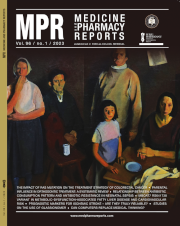Combined conservative treatment of a recurrent mandibular keratocyst by enucleation, diode laser, 5-Fluorouracil and dental implants: a case report with 18 years-follow up
DOI:
https://doi.org/10.15386/mpr-2067Keywords:
keratocyst, odontogenic cysts, mandible, diode laser, 5-FluorouracilAbstract
In 2017, the World Health Organization classified the odontogenic keratocyst as a developmental odontogenic cyst. The posterior parts of the mandible, especially the angle and the ramus, are the most involved sites. Due to their high recurrence rate, keratocysts are managed surgically with careful complete excision. Additionally, chemical solutions such as Carnoy's solution, modified Carnoy's solution, and 5-Fluorouracil have been associated with surgical treatment.
Diode lasers generate diverse wavelengths that have photothermal and photochemical special properties and could have some effects on the lining epithelium remnants of the cyst.
In this paper, we discuss a case of mandibular recurrent odontogenic keratocyst treated with 5-Fluorouracil topical application after enucleation and diode laser application with 18 years follow-up and teeth replacement with dental implant.
5-Fluorouracil and diode laser have been found to be very effective in the treatment of keratocysts.
Downloads
Published
How to Cite
Issue
Section
License
The authors are required to transfer the copyright of the published paper to the journal. This is done by agreeing to sign the Copyright Assignment Form. Whenever the case, authors are also required to send permissions to reproduce material (such as illustrations) from the copyright holder.

The papers published in the journal are licensed under a Creative Commons Attribution-NonCommercial-NoDerivatives 4.0 International License.

